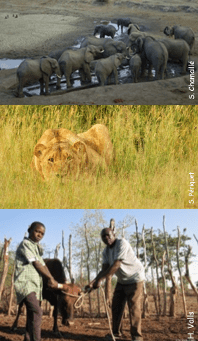Quantitative and Evolutionary Ecology of Communities Group
Members

Doctorante
UCBL

Professeure des universités
VetAgro-Sup
Tel: 33 04 72 43 27 56

Directeur de recherche
CNRS
Tel: 33 04 72 43 27 57

Doctorant
UCBL
Tel: 04 72 44 81 42

Doctorant
CNRS
Tel: 04 72 44 81 42
Doctorant
VetAgro-Sup

Maître de conférences
UCBL
Tel: 04 72 44 81 42
Doctorant
UCBL


Professeur des universités
UCBL
Tel: 33 04 72 43 27 56

Professeur des universités
UCBL

Directeur de recherche
CNRS
Tel: 33 04 72 43 27 56

Maîtresse de conférences
UCBL
Tel: 33 04 72 43 29 02
Maître de conférences
UCBL
Tel: 33 04 72 43 29 02

Our research activities, focused on interspecific interactions (community ecology), aim to better understand the ecological and evolutionary processes structuring species assemblages and biodiversity at different temporal and spatial scales. Our team addresses these major issues using contrasting biological models (communities of large African mammals, insects, microbiota, plants) from 3 complementary angles:
- Our work is strongly anchored in the conceptual framework of evolutionary biology by studying (i) the diversity of adaptive responses implemented by organisms to selective pressures in their environment, (ii) their consequences on population demography and ultimately (iii) the dynamics and composition of species communities.
- Our research is closely linked to societal issues of biodiversity conservation and management by integrating both the functioning of socio-ecological systems and the context of climate change. We conduct experimental studies, manage and ensure the long-term monitoring of several community observation networks.
- Methodological issues also occupy a central place in our team, with the development of new tools for statistical processing and modeling of ecological data. This activity leads to the development of methods and software that we develop and distribute freely.
Research programs

Functioning of African savanna communities
The Hwange LTSER (Long-Term Socio-Ecological Research site in Zimbabwe hosts a long-term interdisciplinary research program that focuses on the functioning of plant and animal communities within the Hwange National Park and the interactions between this protected area and humans living in its periphery. Based on this program, three axes are developed: (1) studying the population dynamics of elephants, exploring their impact and that of management policies on the socio-ecosystem functioning; (2) Understanding the extent to which interactions within and between trophic levels are sensitive to management actions (e.g. sport hunting, water management) and climate change; (3) Decoding human ecology and human-wildlife coexistence mechanisms towards integrated conservation and sustainable functioning of the socio-ecosystem. This research is complemented by more recent works in the Hluhluwe-iMfolozi Park and in the Madikwe reserve in South Africa, which focus on the role of environmental conditions on the hunting success of large African carnivores. We work in close collaboration with the IRL (International Research Lab) Rehabs.
Involved group members : Alice Bernard, Laura Lacomme, Aïssa Morin, Lisa Nicvert, Elie Pedarros, Yolan Richard, Marion Valeix*

Masting and the community dynamics of seed consumers
Masting is a reproductive strategy often encountered in perennial plants, characterized by fructifications highly fluctuating in time and being synchronized at the population level. The seeds produced that way constitute a pulsed resource with a strong impact on the eco-evolutionary dynamics of seed-consuming communities and forest regeneration. Our lack of knowledge of this system still impedes our understanding of the dynamics of temperate forest ecosystems and its future in the context of climate change. Our work carried out on oak forests aims to better understand (i) the proximal causes of masting, (ii) the mechanisms underlying the coexistence of species competing for such highly fluctuating resource and (iii) the co-evolution of consumer exploitation strategies for the fluctuating resource and forest tree fruiting strategies. On the basis of the results obtained, scenarii will be proposed on the future of forest regeneration under climate change, that may serve forest management.
Involved group members : Marie-Claude Bel-Venner*, Emilie Fleurot, Léa Keurinck, Jean Lobry, Samuel Venner

The spread of antibiotic resistance genes in bacteria
Antibiotic resistance is recognized as one of the greatest current threats to human health, and the mobile genetic elements (MGEs) that circulate in bacterial populations and communities are the main vehicles. To understand the dynamics and diversity of MGEs in bacterial pangenomes and the emergence of antibiotic resistance genes, we propose to go beyond the framework of conventional genomics by considering pangenomes as complex ecological communities. In the Ab-One program, we mobilize the concepts and tools developed in community ecology based on an integrative approach (monitoring of bacterial populations/communities evolving in contrasting environments -One-Health approaches-, pan-genomic analyses, experimentation in molecular and cellular microbiology, mathematical modelling). This program is currently focused on the dynamics of MGEs in Acinetobacter baumannii, an antibiotic-resistant microorganism classified as a priority by the WHO. Other more general approaches will illustrate the relevance of this new conceptual framework to understand the dynamics and diversity of MGEs in bacterial pangenomes. This program, co-piloted by our team and a team from CIRI (Horigene) involves the participation of 9 organizations (6 from Lyon -LBBE, CIRI, MMSB, HCL, LEM, VetAgro Sup-, Institut Pasteur (Paris), LMGM (Toulouse ), Robert Koch Institute (Germany)).
Involved group members : Stéphane Dray, Rémi Tuffet, Samuel Venner*

Statistical analysis of ecological data
Understanding the structure and dynamics of species assemblages, and the processes behind them, requires collecting data that are becoming increasingly complex owing to the sophisticated technological developments made available for their acquisition (e.g. GPS, loggers, satellite imagery, molecular data). We are developing new methods for analysing such data, that provide new insights into the ecological processes at work in communities. Multivariate analysis methods allow the analysis of spatial structures, accounting for various information on species (functional traits, morphology, phylogeny), the spatio-temporal variation of species-environment relationships or the multifaceted perception of the protected human-environment relationship. We also model multi-'omics' dose-response data within communities in order to better understand the Adverse Outcome Pathway (AOP) and to better appreciate the risks to the environment. These methodological innovations are made available to the scientific community through the development, distribution and maintenance of software (libraries for the R language: ade4, adegraphics, adephylo, ade4TkGUI, nlstools, fitdistrplus, DRomics, seqinr).
Involved group members: Marie Laure Delignette-Muller, Stéphane Dray*, Jean Lobry, Jean Thioulouse.
Publications
Display of 1 to 30 publications on 656 in total
Cluefish: mining the dark matter of transcriptional data series with over-representation analysis enhanced by aggregated biological prior knowledge
NAR Genomics and Bioinformatics . 7 ( 3 ) : lqaf103
Journal article
see the publicationExploring transcriptomic data with over-representation analysis enhanced by aggregated biological prior knowledge
35th Society of Environmental Toxicology and Chemistry (SETAC 2025) .
Conference paper
see the publicationEnvironmental radioactivity impacts bioenergetic in tree frog of Fukushima
Environmental Pollution . : 127147
Journal article
see the publicationDiversité Taxonomique et Structure des Communautés D'hétéroptères Aquatiques (Heteroptera) Du Bassin Versant De La Medjerda (Tunisie Septentrionale)
Revue de la Faculté des Sciences de Bizerte . 23 : 241-258
Journal article
see the publicationTrait matching without traits: using correspondence analysis to investigate the latent structure of interaction networks
Peer Community Journal . 5 : e73
Journal article
see the publicationPerformance of Segmentation Methods Applied to River continuum at Network scale
Conférence internationale I.S.Rivers 2025 .
Poster
see the publicationNatural Disturbances and Connectivity Drive Seasonal Taxonomic and Trait Patterns of Aquatic Macroinvertebrate Communities Across Europe
Global Ecology and Biogeography . 34 ( 5 )
DOI: 10.1111/geb.70047
Journal article
see the publicationExploring the spatio-temporal dynamics of disturbed metacommunities: A mechanistic modeling approach to species resistance and resilience strategies in drying river networks
Ecological Modelling . 506 : 111136
Journal article
see the publicationA New Census of Alien Weeds Present in Crops of Oranie (Northwest Algeria) and a Comparative Study of Their Functional Traits With Native Weeds
Agriculture and Forestry Journal . 9 ( 1 ) : 23-30
Journal article
see the publicationZero‐shot animal behaviour classification with vision‐language foundation models
Methods in Ecology and Evolution . 16 ( 7 ) : 1460-1472
Journal article
see the publicationEnvironmental factors governing spatio-temporal series of aquatic vegetation in the Bagnas lagoon
Estuarine, Coastal and Shelf Science . 319 : 109261
Journal article
see the publicationHarmonisation of the diagnostic performances of serological ELISA tests for C. burnetii in ruminants in the absence of a gold standard: Optimal cut-offs and performances reassessment
Preventive Veterinary Medicine . 239 : 106509
Journal article
see the publicationFrom dose-response modelling of transcriptomic data to biological interpretation: an application to embryonic exposure of zebrafish (Danio rerio) to di-n-butyl phthalate (DBP)
22nd Pollutant Responses in Marine Organisms Symposium (PRIMO22) .
Poster
see the publicationInterests and constraints towards unravelling endocrine disruptors mechanisms using dose-response transcriptomic data: application to the impact of di-n-butyl phthalate on zebrafish
22nd Pollutant Responses in Marine Organisms (PRIMO22) .
Conference paper
see the publicationIntransitive competition: an important mechanism?
SFE2 International congress in ecology and evolution .
Conference paper
see the publicationHarmonisation of the diagnostic performances of serological ELISA tests for C. burnetii in ruminants: optimal positivity thresholds and performance reassessment
Preprint
see the publicationProtein expression patterns and activities of two metabolic enzymes (CS and LDH) highlight a disturbance in the metabolic pathways of tree frogs living in the Chernobyl Exclusion Zone
6th International Conference on Radioecology & Environmental Radioactivity .
Poster
see the publicationAOP in the context of radioecology: challenges and insights
ERPW2024 - European radiation protection week .
Conference paper
see the publicationDécrypter les mécanismes de reprotoxicité radio-induite chez l'amphipode Gammarus fossarum
Société d'écotoxicologie fondamentale et appliquée (SEFA) .
Conference paper
see the publicationCan plants build their niche through modulation of soil microbial activities linked with nitrogen cycling? A test with Arabidopsis thaliana
New Phytologist . 243 ( 2 ) : 620-635
DOI: 10.1111/nph.19870
Journal article
see the publicationAssessing mutualistic metacommunity capacity by integrating spatial and interaction networks
Theoretical Population Biology . 156 : 22-39
Journal article
see the publicationA set of ecosystem service indicators for European grasslands based on botanical surveys
Grassland Research . 3 ( 1 ) : 43-56
DOI: 10.1002/glr2.12069
Journal article
see the publication19. Colistin resistance in pigs – assessing the effectiveness of mitigation measures
Animal. Science proceedings . 15 ( 4 ) : 268-269
Journal article
see the publicationReconciling Pollen Limitation Theories: Insights From Temperate Oak Masting
Ecology Letters . 27 ( 11 ) : e70009
DOI: 10.1111/ele.70009
Journal article
see the publicationGenomics unveils country-to-country transmission between animal hospitals of a multidrug-resistant and sequence type 2 Acinetobacter baumannii clone
Microbial Genomics . 10 ( 10 )
Journal article
see the publicationTrait matching without traits: using correspondence analysis to analyze the latent structure of interaction networks
Preprint
see the publication
You also, comment on this article